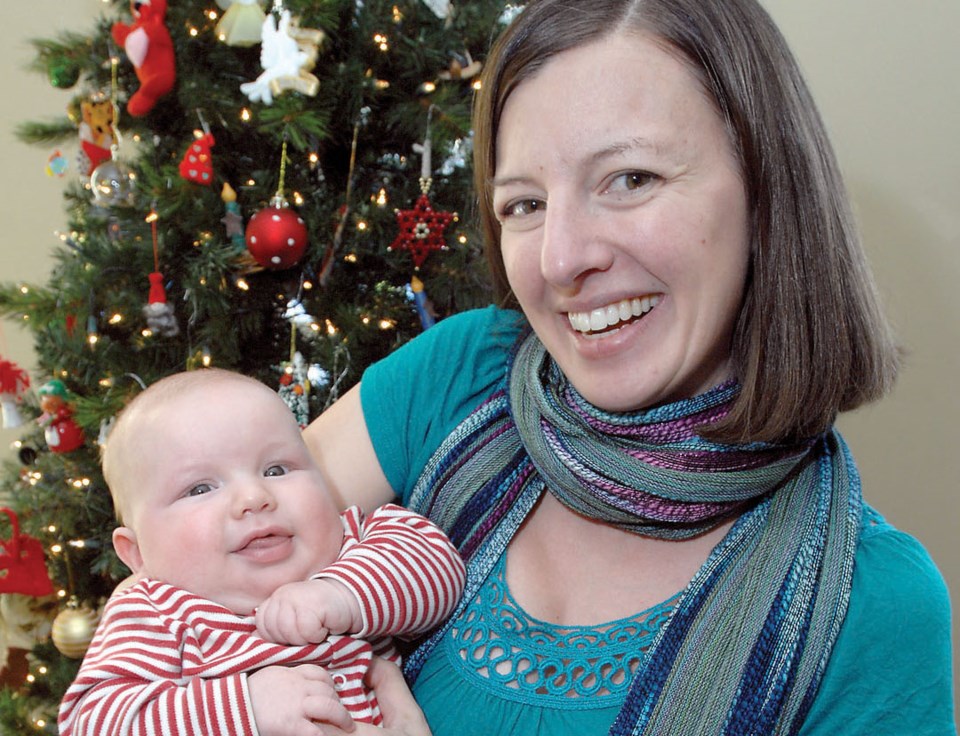When Owen Naphtali grows up to be a man, chances are he will follow the lead of his parents and become a blood donor.
His mom and dad, Katie and Corey, will remind him what happened in those hectic first few hours of his life on Aug. 23, when he was rushed from UHNBC to B.C. Children's Hospital for surgery to correct a heart defect. Blood and tissue donations kept him alive.
"He literally had his wires crossed," said Katie. "Everything seemed fine for the first six hours and then he just started to turn blue. They suspected he had a heart issue going on and we were medevaced that evening to Vancouver."
Doctors determined the main arteries of his heart were attached to the wrong sides. His pulmonary artery (which carries blood to the heart, which then pumps it to the lungs) and his aorta (which carries oxygen-rich blood to the heart before it is sent to the body) had to be separated and reattached to the correct chambers.
"There was no mixing of blood happening," said Katie. "The surgeon (Sanji Gandhi) said it was relatively easy surgery to fix, if you consider open-heart surgery. They've only been doing that procedure since the 80s and the oldest survivor is 25, so they don't know, statistically, what happens when you're 40. But for now, he's doing beautifully."
Am adult heart is the size of a fist but in a week-old infant, the heart is only as big as an adult's thumb. "They put hundreds of sutures in," said Katie. "His heart is made of silk now. It's really incredible."
Owen was seen twice by a cardiologist and each time passed his examination. The Naphtalis were told he won't need a follow-up visit for another six months.
"He passed all his tests and they said he's become a poster boy for heart arterial switch surgery," said Katie.
Immediately after he arrived in Vancouver and four days before his major surgery, Owen underwent a procedure in which doctors carved out a hole in his heart, which allowed blood to mix in his heart and kept him alive. Four days later, the surgical team was assembled for a six-hour surgery that was completed without complications. The hole was filled in with a cadaver tissue transplant.
The Naphtalis plan to register that Owen received a donated tissue transplant to allow the family members of the donor, if they so choose, to contact them.
"Hopefully we can connect with them to let a grieving family know what happened with that little piece of heart," said Katie. "I don't know how much blood he needed, I just know he needed blood when he was on the heart-lung machine."
As students at the University of Victoria, Katie and Corey, now both 33, regularly gave blood at donor clinics but stopped in 2002. Since Owen's operation, Corey has donated two units at the Canadian Blood Services clinic and plans to continue that every 56 days, the minimum wait period. Katie, a native of Prince George, will also give blood once she finishes breastfeeding Owen.
"We never really thought about what happened to our blood afterward, it was never a very specific or personal thing for us," said Katie. "I just thought recipients of blood were people who got into car accidents but I've come to know it's required for all kinds of surgeries not related to trauma and people suffering from leukemia and chronic illnesses require blood too. Suddenly it became real to us that it's because of this blood and this tissue that our son is with us today."
Owen is the youngest of three children. The Naphtalis also have a five-year-old daughter, Isabelle, and a three-year-old son, Oliver. As a baby, Isabelle spent time in B.C. Children's Hospital to fix an internal abdominal birth defect, which helped prepare the older kids for Owen's surgery.
n Canadian Blood Services is into its second week of Bleed and Feed, a program to support local food banks as well as blood donor clinics. Until Jan. 2, blood donors are being encouraged to bring non-perishable food items with them to the clinic at 2277 Westwood Dr., which is open Wednesdays and Thursdays from 11 a.m. to 6 p.m. It is also open every fourth Saturday. Jan. 5 is the next Saturday clinic.
The goal of the month-long program is is to collect at least 14,000 units of blood, while also easing the hunger pangs of an estimated 100,000 people who rely on food banks in B.C.
"We're trying to make it easier for people to give and cover two things at once," said Amy Erickson, a partnership specialist with Canadian Blood Services.
"So far, it hasn't been as successful as it has been in other regions in B.C. We just started last Wednesday, when the clinic opened, and we've collected a couple of bags of food."
The Prince George clinic usually comes close to reaching its daily blood target of 59 donations per day. Several work places, including Northland Dodge Jeep Chrysler, the RCMP, and the City of Prince George, have encouraged employees to sign up for the clinics and they have almost filled the appointment book for December. But Erickson said there are very few appointments booked for Jan. 2 and 3.
"Students are in the middle of exams and people are going on holidays, so it is tough in December," said Erickson.



